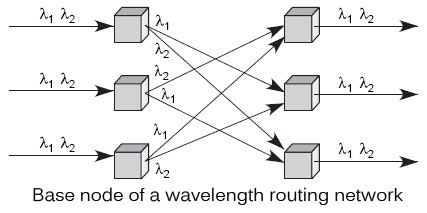The idea at the basis of the wavelength routing network consists of maximum reuse the same wavelengths. The figure illustrates a node of a routing network wherein wavelengths of the same wavelength are used repeatedly.

This architecture is a fixed routing on wavelengths. We can also develop in wavelength routed networks with dynamic routing in time. For this purpose, it is necessary to insert optical or optoelectronic switches, according to the technology used, between transmit and receive ports. An example of this technique is illustrated in Figure.

Much research still takes place in the field of optics to optimize the use of wavelengths. This technique achieves particularly high flow rates, which are measured in terabits per second. The difficulties are still high cost of the wavelength-division multiplexing and especially optical switches. When we want to minimize the cost and increase the range, use optoelectronic switches. Certain fragility is visible at each passage of a light environment to an electrical environment. Considerable progress still needed to reamplify optically signals and adjust almost instantly emission or reception couplers on the right wavelength.
 Dinesh Thakur holds an B.C.A, MCDBA, MCSD certifications. Dinesh authors the hugely popular
Dinesh Thakur holds an B.C.A, MCDBA, MCSD certifications. Dinesh authors the hugely popular